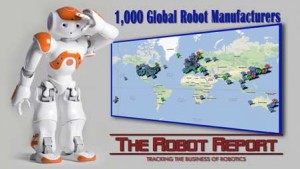
Robohub.org
1,000 Robot Makers!
Well — almost 1,000. Presented on this map are 977 robot manufacturers and the top 20 robotics universities and research facilities. Every type of company; every facet of the industry; most industrialized countries of the world are represented. From big companies like KUKA, ABB and Fanuc to start-ups like Redwood Robotics in California and Etnamatica in Sicily; from Iceland to Western Australia. These companies are robot makers; they may or may not also be robot users. That’s for another map.
Red markers reflect 200+ industrial robot makers; Green is for the 170+ start-up companies; and Blue is separated into two groups: “S” for service robots for governmental and corporate use while “P” covers service robots for private or personal use. Yellow is used to show the location of the top 20 robotic research and educational facilities. A country-by-country table is shown below.
The global map does not cover an additional 825 ancillary businesses such as image systems, software developers, engineering and consulting firms, integrators and resellers, designers, servo, laser and stereo camera providers, etc. Nor does it cover 225 other educational facilities and research labs. These can be found in our Ancillary Businesses and Educational and Research Facilities Directories.
The map is also limited by my own research capabilities, language translation limitations, and scarcity of information about robotics companies in emerging countries. It show a single entry for a company headquarters regardless how many branches, subsidiaries and locations that company might have.
In spite of all those caveats, at first glance I was impressed by the sheer quantity of the markers. One can easily see that many of the start-ups and service robotics companies are located near prominent Yellow-marked universities and research labs in clusters surrounding Carnegie Mellon, MIT and Harvard, UC Berkeley, Stanford and Willow Garage, the University of Tokyo and TITECH, etc. Or areas of innovation and energy like Seoul, Korea, Israel and New York City.
Red markers – industrial robot makers – stand out for their predominance in the industrial sections of the world: Germany, Switzerland and Central and Western Europe and the UK, Japan, Korea and the Great Lakes area of the US.
Blue markers – service robots (every other type of robot except industrial) are everywhere as are Green start-up markers. These are the emerging robotics companies in non-industrial robotics: robots used in healthcare, scientific labs, for defense and security, in academia, as toys, for remote presence and autonomous mobility underwater, on the ground and in the air and for a myriad of other uses.
This map will continue to grow above the 1,000 mark as I continue my research. If I’ve missed your company or companies that you know about, please send me a message.
Frank Tobe
is the owner and publisher of The Robot Report, and is also a panel member for Robohub's Robotics by Invitation series.
Frank Tobe
is the owner and publisher of The Robot Report, and is also a panel member for Robohub's Robotics by Invitation series.
Related posts :
Generations in Dialogue: Human-robot interactions and social robotics with Professor Marynel Vasquez
Catch the latest podcast in the new series from AAAI.
Robot Talk Episode 137 – Getting two-legged robots moving, with Oluwami Dosunmu-Ogunbi
Robot Talk
12 Dec 2025
In the latest episode of the Robot Talk podcast, Claire chatted to Oluwami Dosunmu-Ogunbi from Ohio Northern University about bipedal robots that can walk and even climb stairs.
Radboud chemists are working with companies and robots on the transition from oil-based to bio-based materials
Radboud University
10 Dec 2025
The search for new materials can be accelerated by using robots and AI models.
Generations in Dialogue: Embodied AI, robotics, perception, and action with Professor Roberto Martín-Martín
Catch the latest podcast in the new series from AAAI.
Robot Talk Episode 136 – Making driverless vehicles smarter, with Shimon Whiteson
Robot Talk
05 Dec 2025
In the latest episode of the Robot Talk podcast, Claire chatted to Shimon Whiteson from Waymo about machine learning for autonomous vehicles.
Teaching robot policies without new demonstrations: interview with Jiahui Zhang and Jesse Zhang
Lucy Smith
04 Dec 2025
Hear from authors of work presented at CoRL 2025.
Why companies don’t share AV crash data – and how they could
Cornell University
01 Dec 2025
Researchers have created a roadmap outlining the barriers and opportunities to encourage AV companies to share the data to make AVs safer.
Robot Talk Episode 135 – Robot anatomy and design, with Chapa Sirithunge
Robot Talk
28 Nov 2025
In the latest episode of the Robot Talk podcast, Claire chatted to Chapa Sirithunge from University of Cambridge about what robots can teach us about human anatomy, and vice versa.




